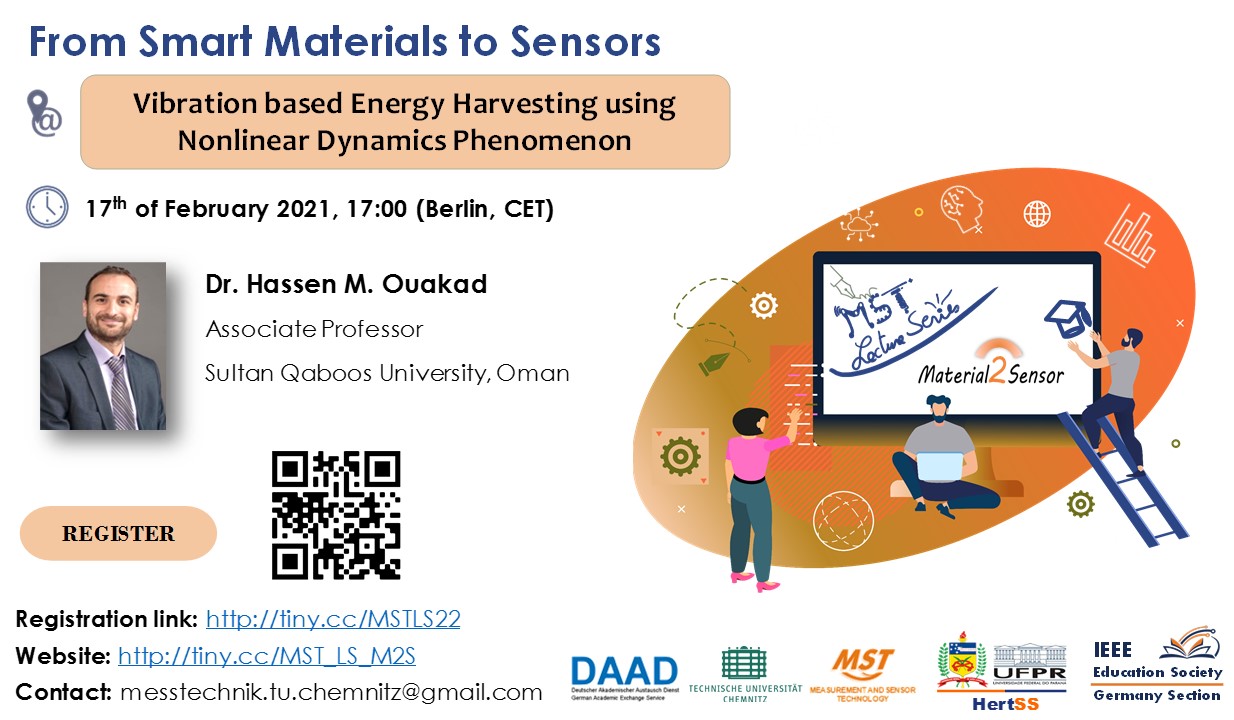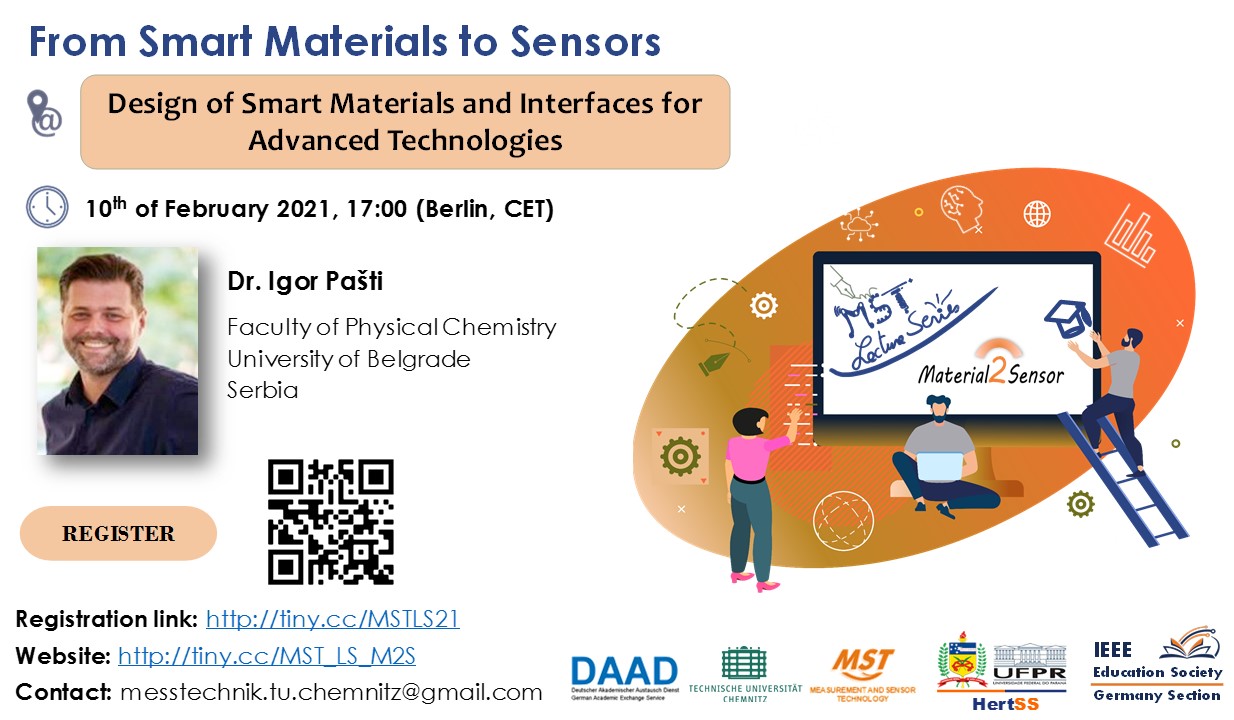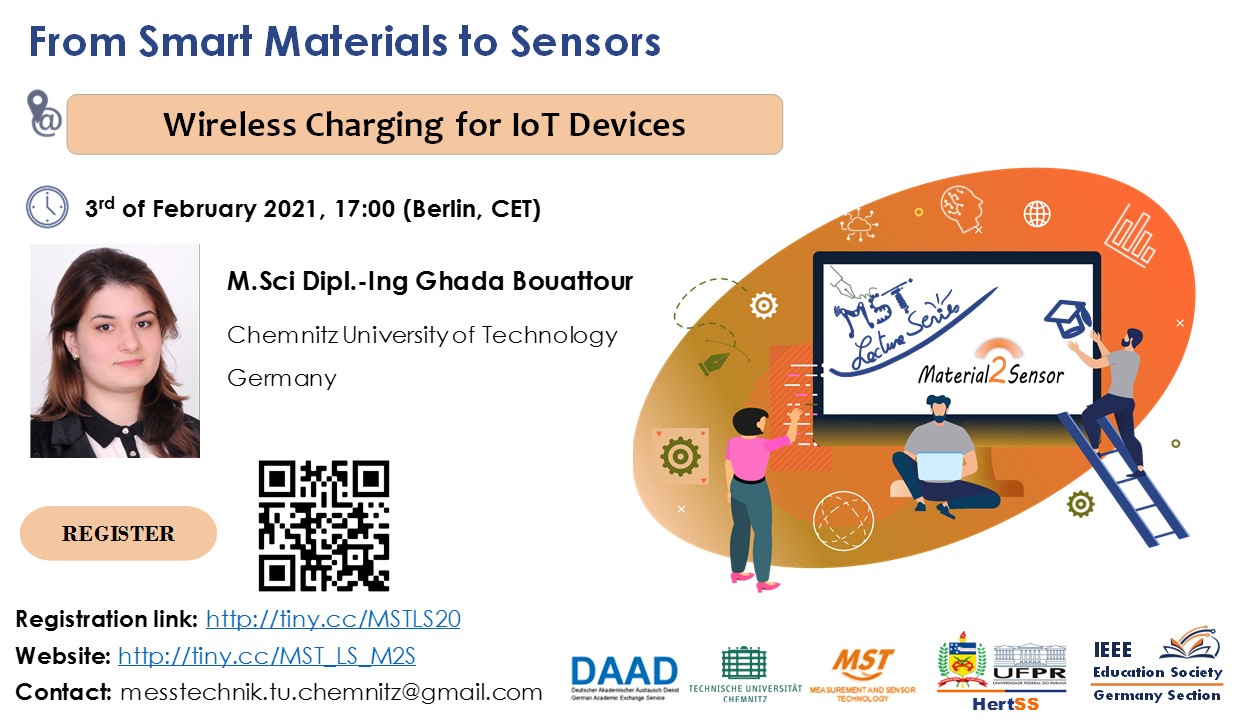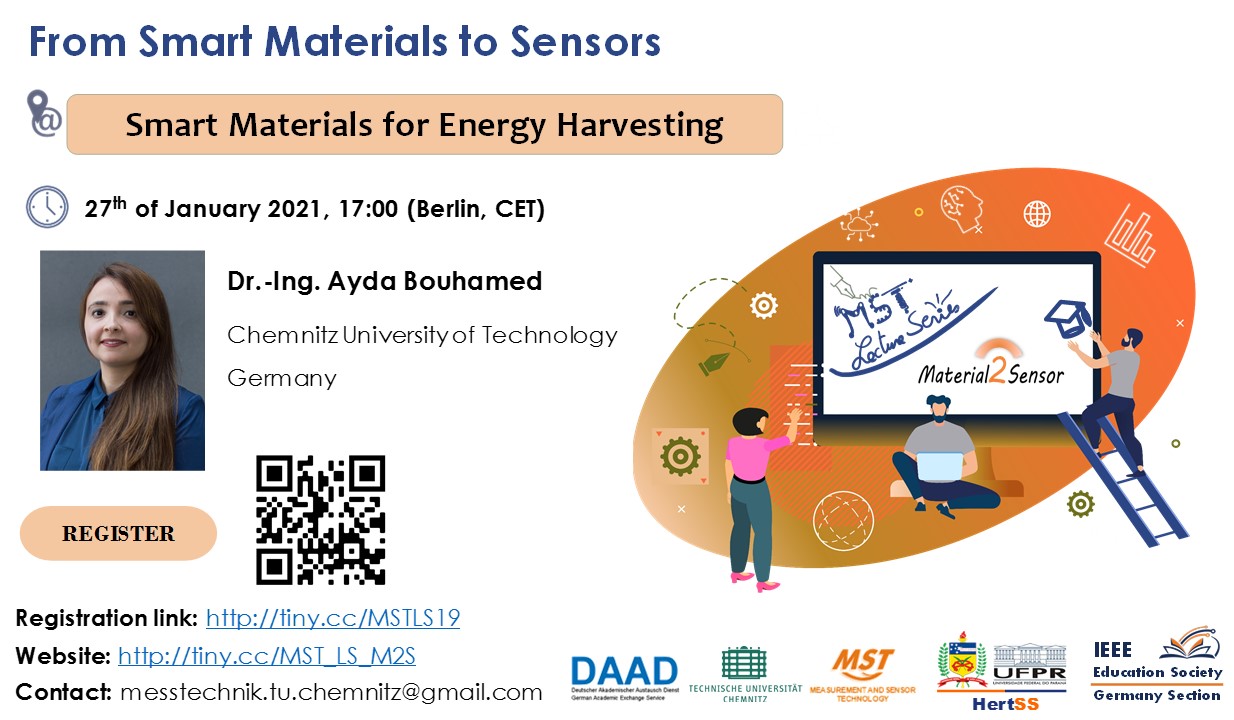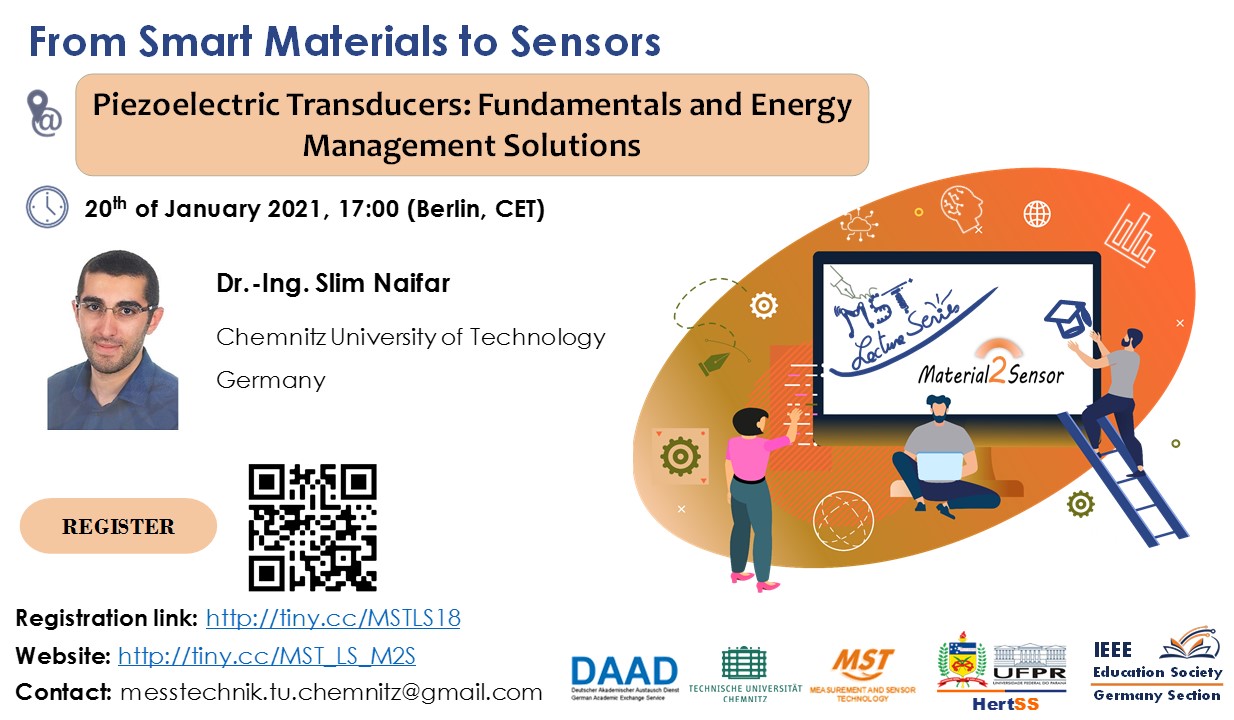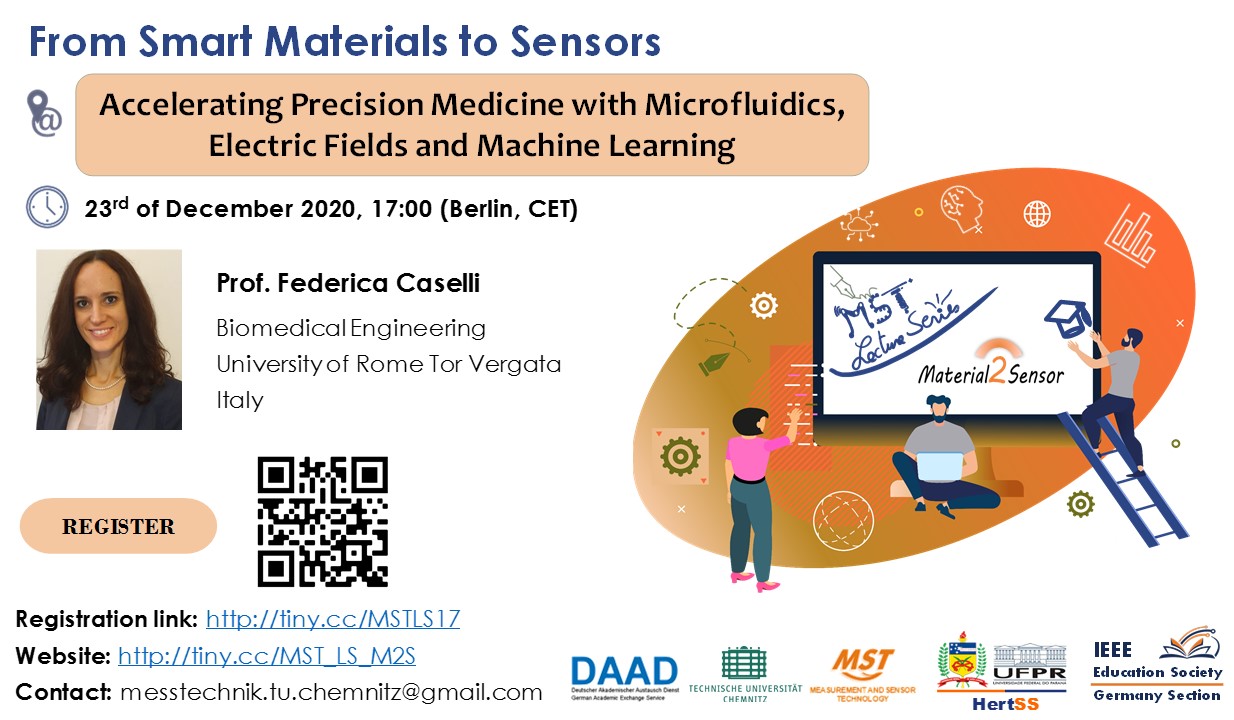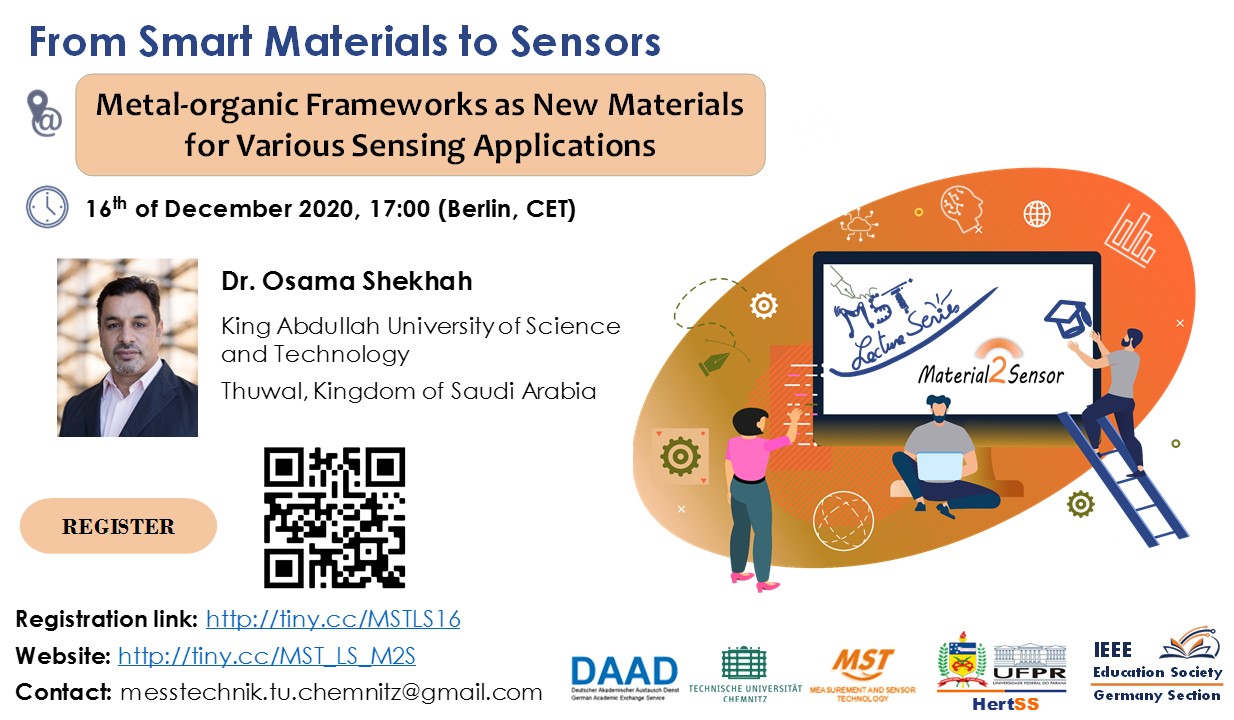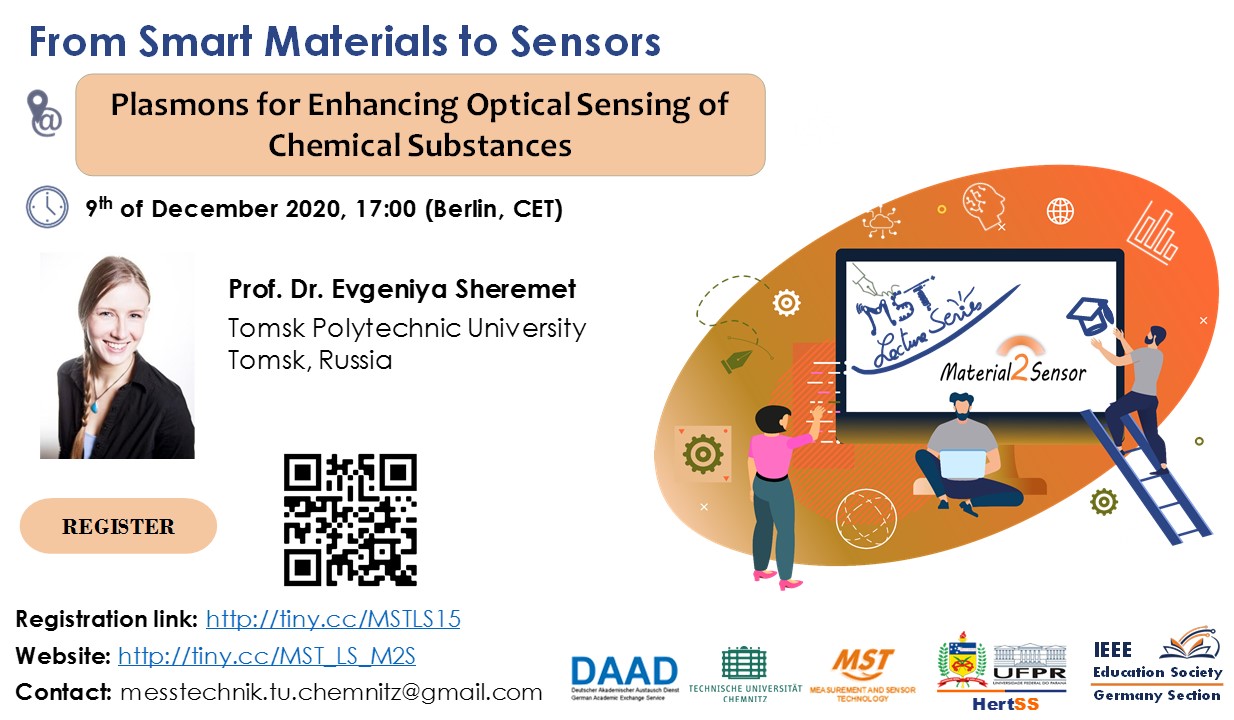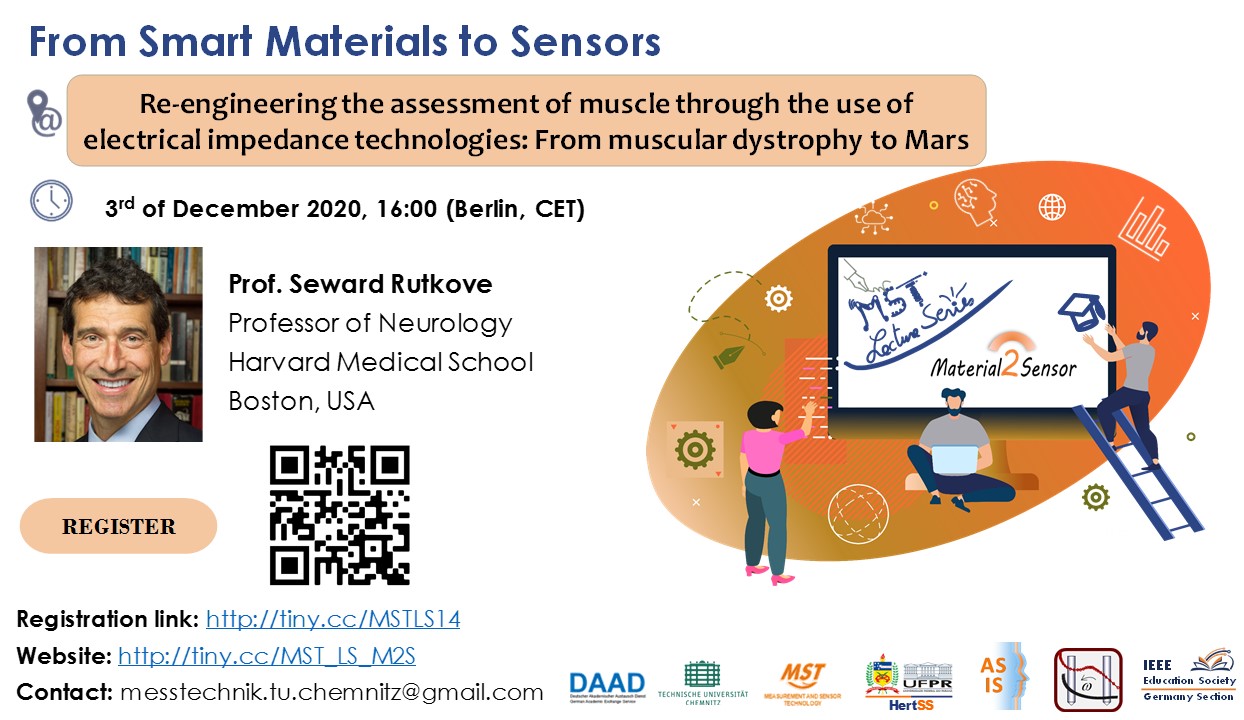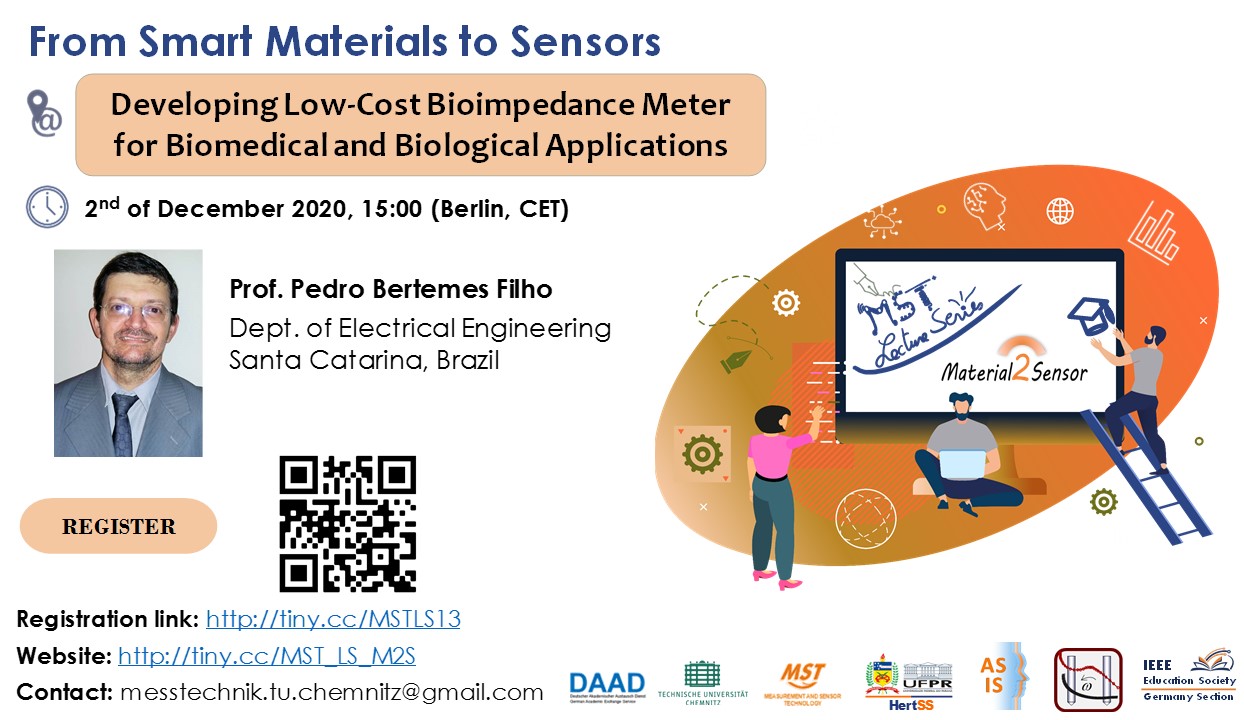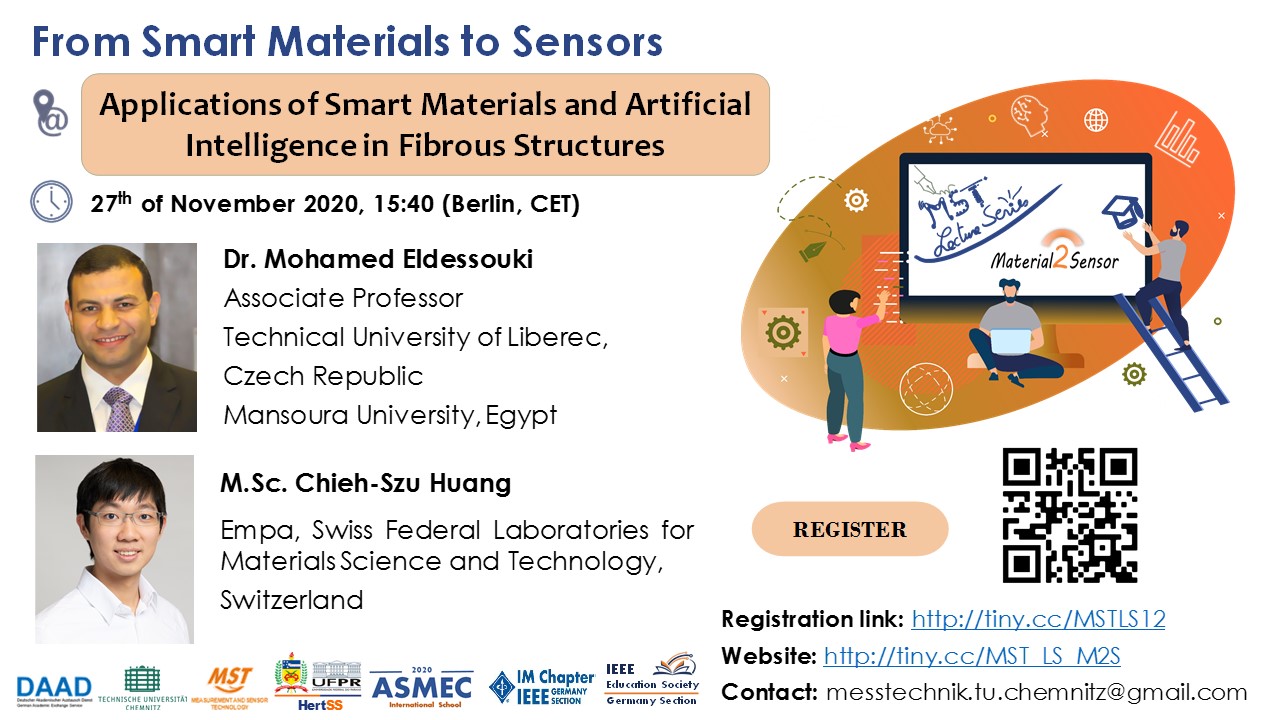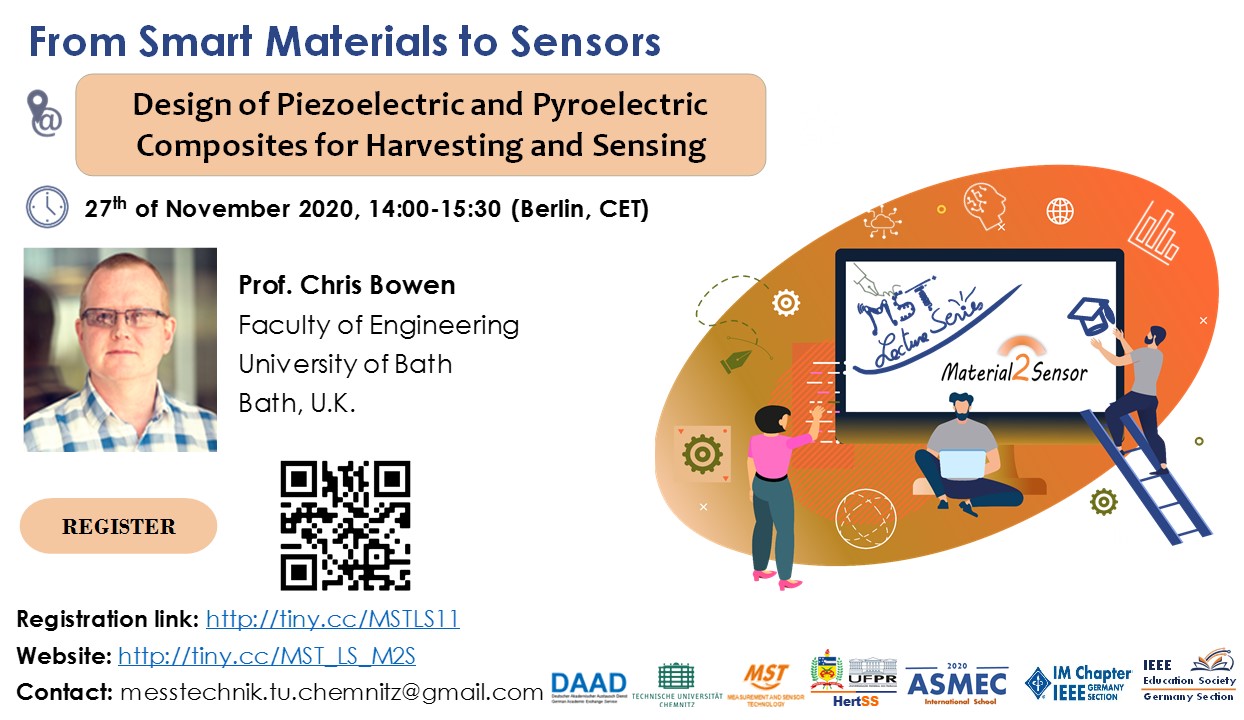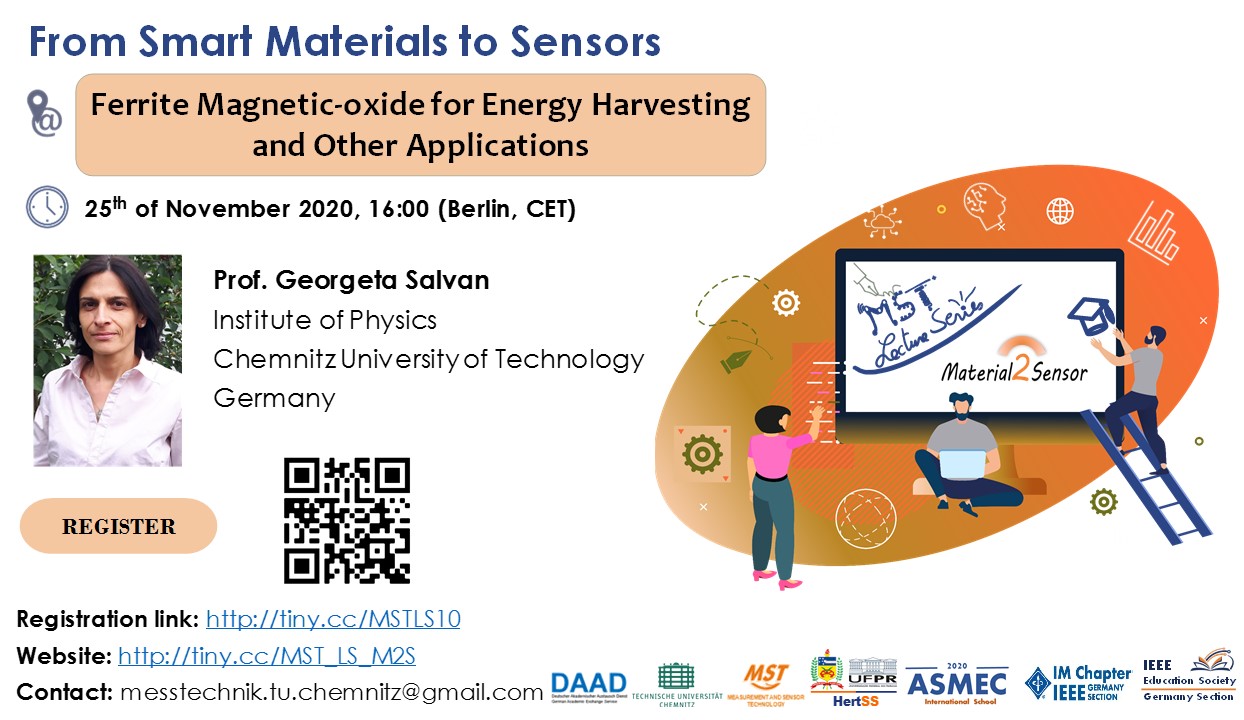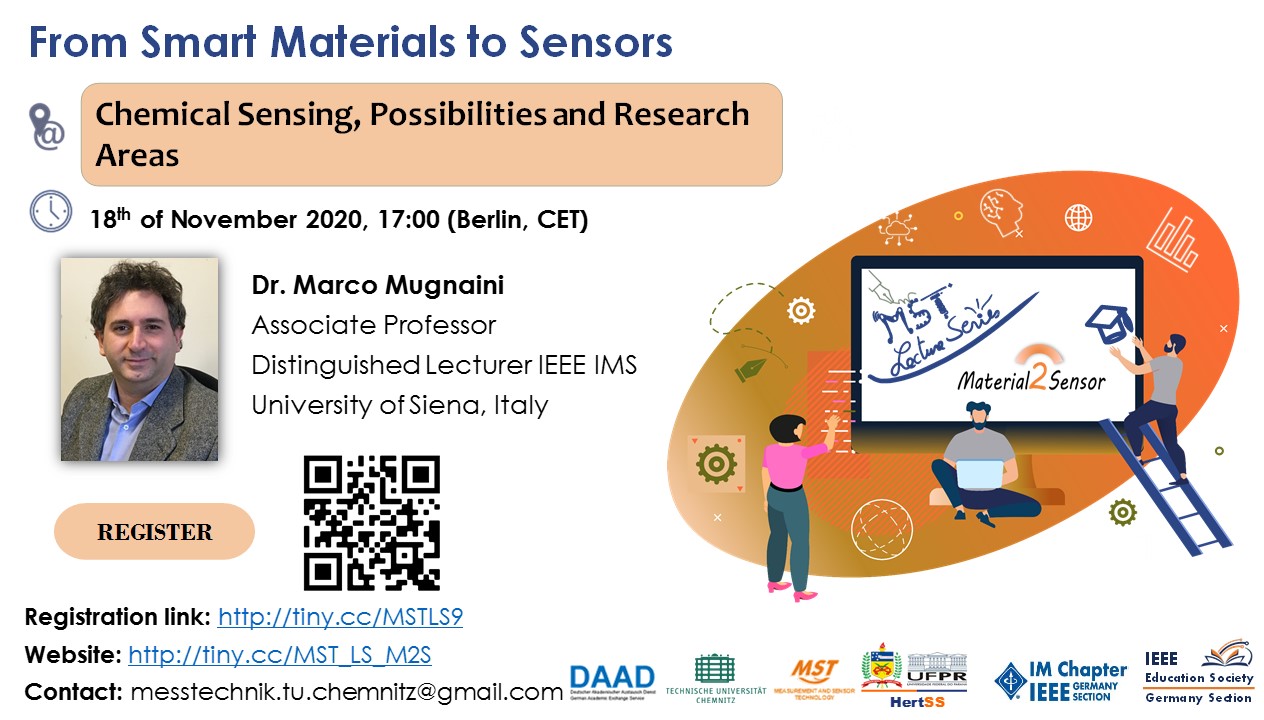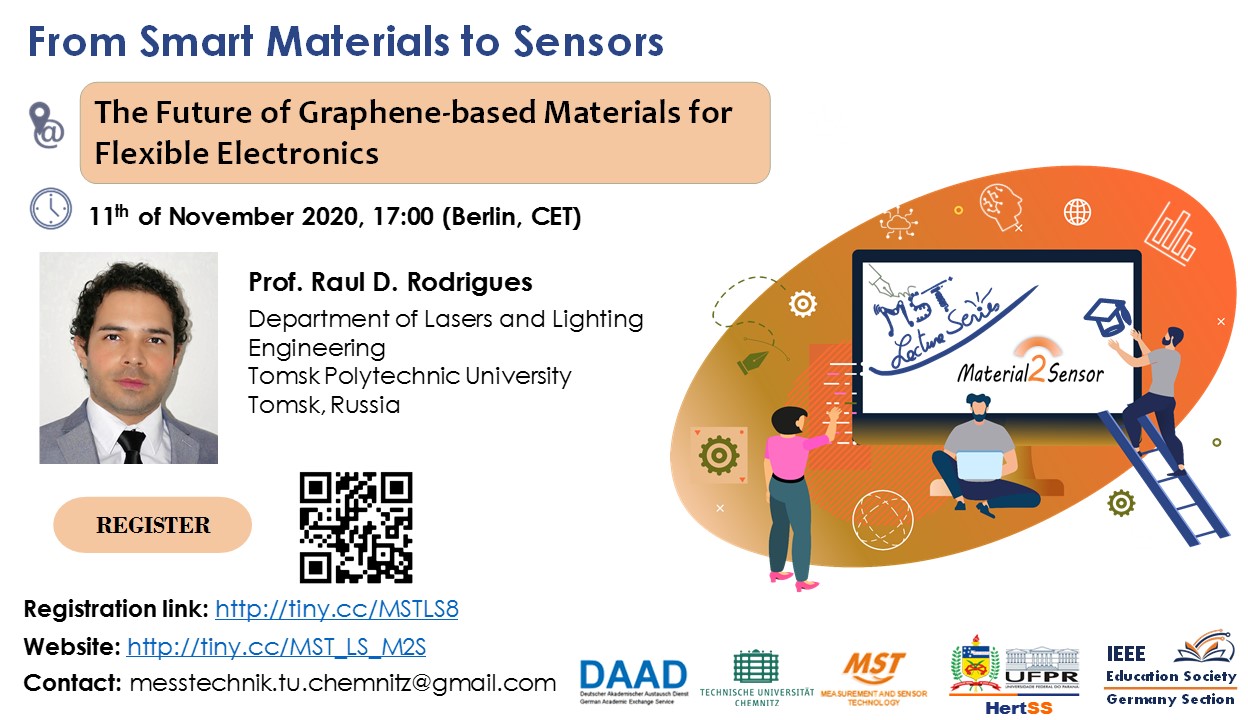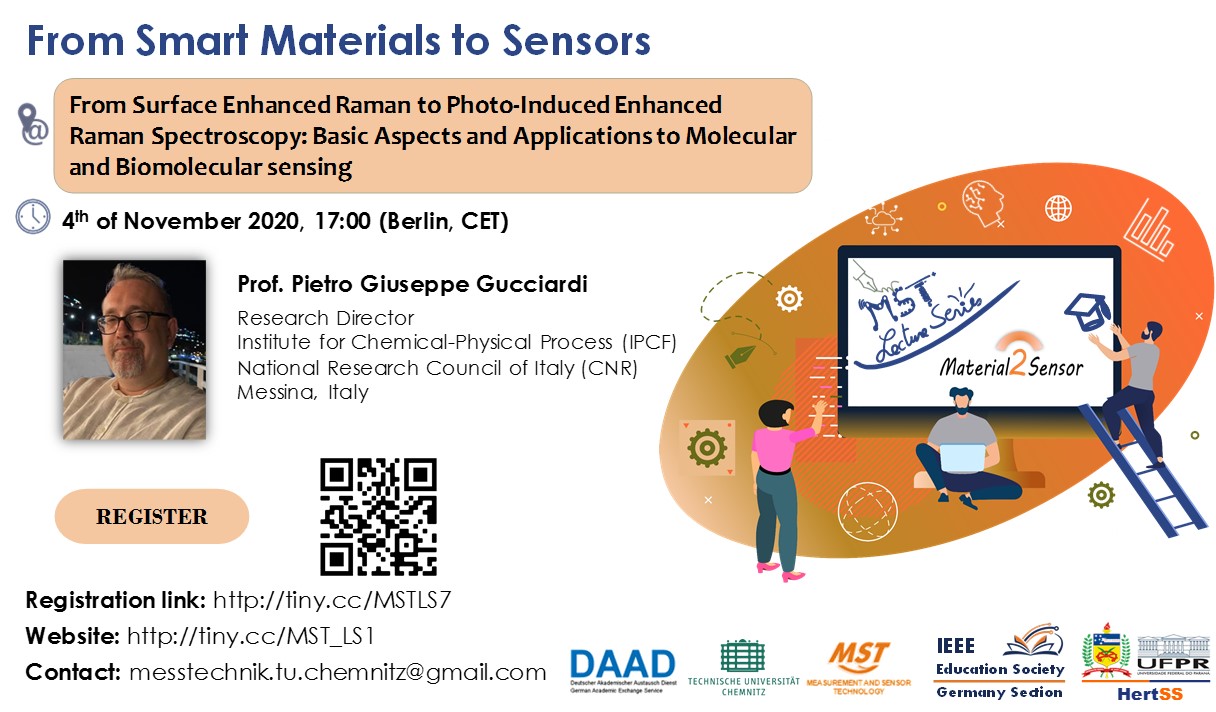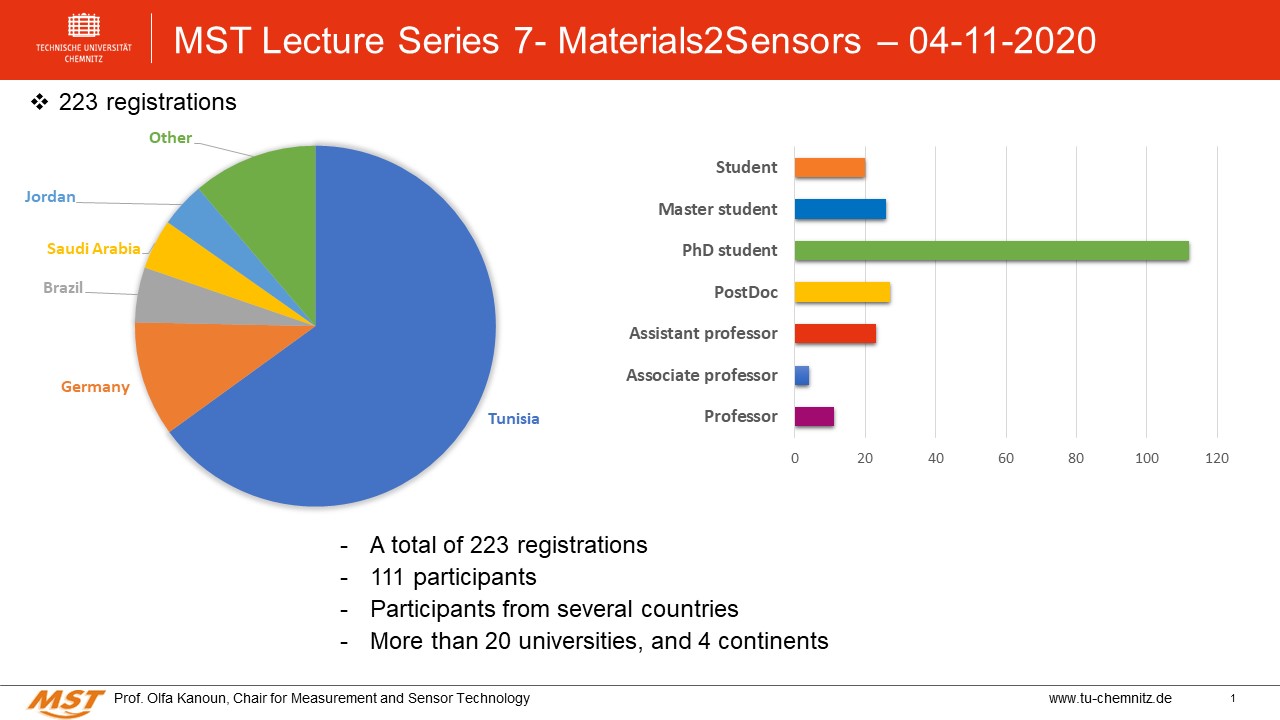MST Lecture Series - From Smart Materials to Sensors
This track of the MST Lecture Series addresses with keynotes given by prominent speakers technologies and smart materials for sensors, such as: Smart and nano materials, surface and solid-state analysis, optical characterization, energy harvesting and physical and chemical sensors.
Webinar, 17th of February 2021, 17:00 (Berlin CET) organized within the activities of the DAAD project HertSS and in cooperation with the German Chapter of the IEEE Education Society
Vibration based Energy Harvesting using Nonlinear Dynamics Phenomenon |
|
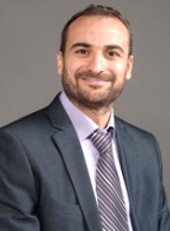 |
Dr. Hassen M. Ouakad He received the B.Sc. degree, with honors, in Mechanics and Structures in 2007 from Tunisia Polytechnic School. In 2008, he received a master degree in Computational Mechanics from a joint graduate program between Tunisia Polytechnic School, Tunisia, and Virginia Tech, VA, USA. Then, he joined the MEMS characterization and Motion Lab of the State University of New-York at Binghamton (NY, ISA), where he received the Ph.D. degree in 2010. In January 2011, he joined the Petroleum Engineering Department at the Texas A&M University in the Education City of Doha, State of Qatar, as a Postdoc Research Assistant. In September 2011, he joined the Mechanical Engineering Department of King Fahd University as an Assistant Professor. He got promoted to the rank of Associate Professor since April 2016. Since September 2018, he joined the Mechanical and Industrial Engineering Department of Sultan Qaboos University (SQU) in Oman as Associate Professor where he currently heads the Mechanical Systems Laboratory. Dr. Ouakad is the recipient of the 2010 Excellence in research award granted by the Watson School of the State University of New-York at Binghamton, NY, USA. He was also awarded both the Excellence in Teaching and the Excellence in Academic Advising from the Engineering College of King Fahd University in May 2016 and April 2017 respectively. Moreover, He was awarded the Excellence in Research Award from the Deanship of Scientific Research at KFUPM back in May 2018. Dr. Ouakad developed and examined numerical/experimental techniques to characterize miniaturized devices rely on non-parallel plates electric actuating fields. He authored and co-authored more than ninety scientific articles published in highly ISI ranked international journals and referred conference proceedings. His work has been cited more than 1700 times and his H index is 20. |
|
Poster: |
|
Webinar, 10th of February 2021, 17:00 (Berlin CET) organized within the activities of the DAAD project HertSS and in cooperation with the German Chapter of the IEEE Education Society
Design of Smart Materials and Interfaces for Advanced Technologies |
|
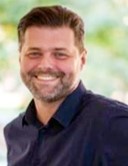 |
Dr. Igor Pašti is associate professor at University of Belgrade, Faculty of Physical Chemistry. He teaches Electrochemistry and Electrochemical Kinetics, Materials Science, Surface Science, and specially designed courses about carbon materials such as Graphene. He supervised 9 PhD theses and over 30 diploma and master works. His research is focused on computational design and development of novel materials for energy conversion applications. So far, he published over 120 papers in international peer reviewed journals, 3 university textbooks and holds three national patents. His papers received over 2500 citations, with h-index 29 (Google Scholar). He is currently leading one national and three international projects, while he participated in 16 international projects up to date. Dr. Pašti is also affiliated researcher of KTH-Royal Institute of Technology, Stockholm, Sweden, at the Department of Materials Science and Engineering. He is also member of the Editorial Board of the journal Catalysts and reviewer for over 50 international peer review journals. |
|
Poster: |
|
Webinar, 3rd of February 2021, 17:00 (Berlin CET) organized within the activities of the DAAD project HertSS and in cooperation with the German Chapter of the IEEE Education Society
Wireless Charging for IoT Devices |
|
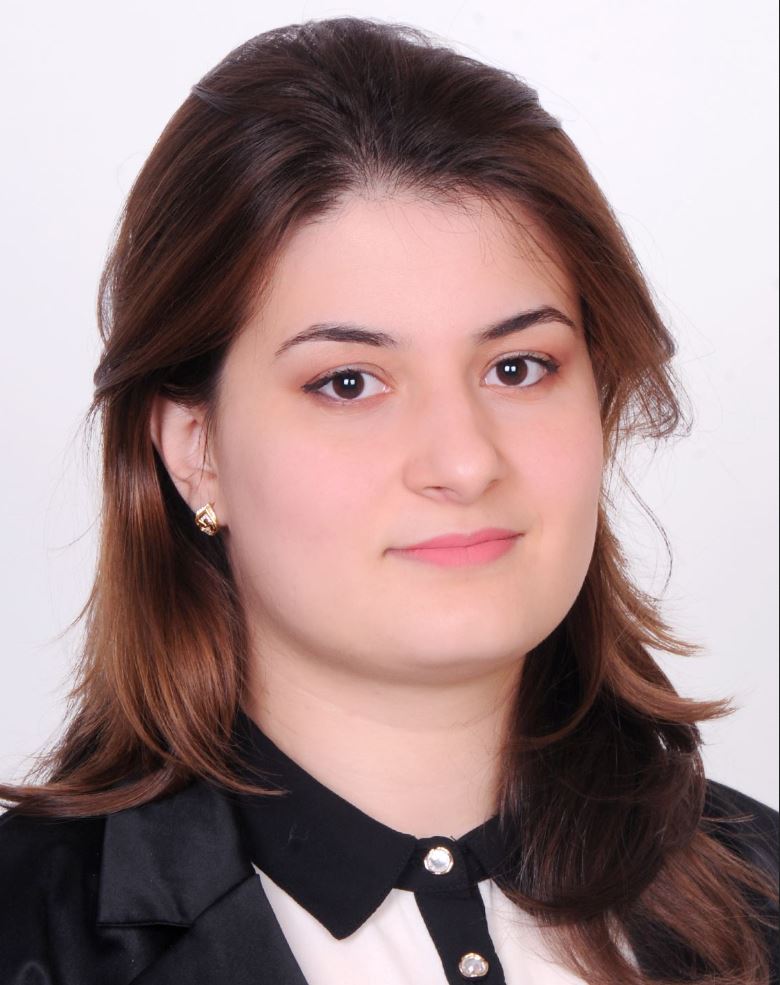 |
M.Sci Dipl.-Ing Ghada Bouattour received the Diploma degree in electrical engineering and the embedded master' s degree from the National School of Engineers of Sfax (ENIS), Sfax, Tunisia, in 2014 and 2015, respectively. She is currently pursuing the Ph.D. degree with the University of Sfax, Sfax, and Chemnitz University of Technology(TUC), Chemnitz, Germany. Her research interests include Wireless power transfer via inductive links. |
|
Poster: |
|
Webinar, 27th of January 2021, 17:00 (Berlin CET) organized within the activities of the DAAD project HertSS and in cooperation with the German Chapter of the IEEE Education Society
Smart Materials for Energy Harvesting |
|
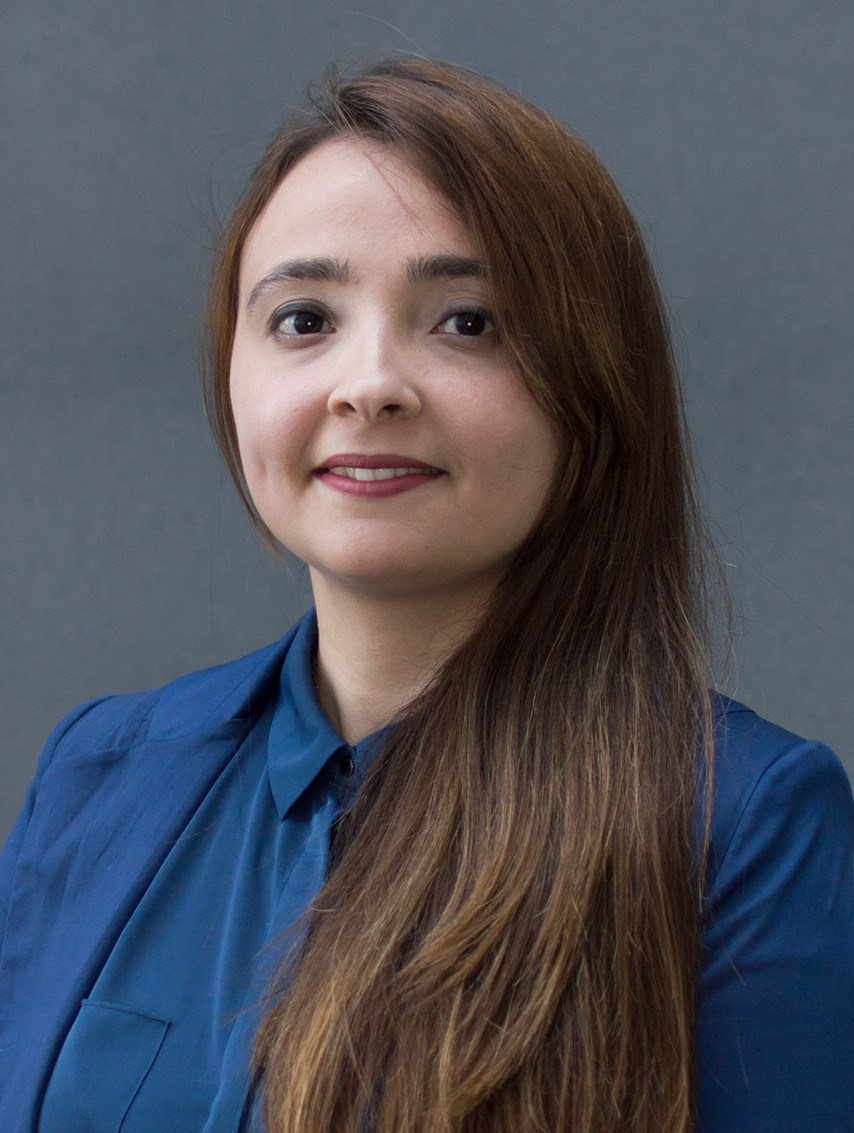 |
Dr. Ayda Bouhamed has obtained her electro-mechanical engineering diploma in 2012 from the National Engineering School of Sfax, Tunisia. She got her doctoral degree in 2018 in electrical engineering from the Chemnitz University of Technology and mechanical engineering from the National School of Engineers of Sfax. She is working as senior research assistant at the chair for Measurement and Sensor Technology (MST). Her research interest includes the development of smart sensors based on carbonaceous materials as well as polymer composites for realization of nanogenerators. |
|
Poster: |
|
Webinar, 20th of January 2021, 17:00 (Berlin CET) organized within the activities of the DAAD project HertSS and in cooperation with the German Chapter of the IEEE Education Society
Piezoelectric Transducers: Fundamentals and Energy Management Solutions |
|
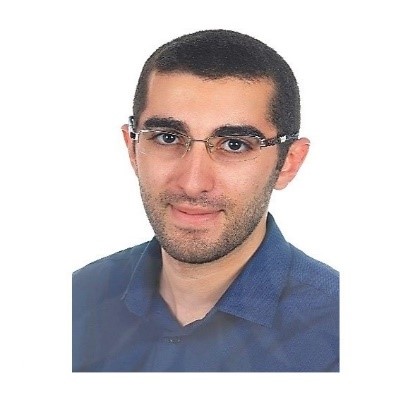 |
Dr. Slim Naifar received his PhD degree in electrical engineering from Chemnitz University of Technology and mechanical engineering from the National Engineering School of Sfax in 2018. He completed in 2013 his Master's degree in Robotics at the National Engineering School of Sfax, Tunisia in cooperation with Rice University in Texas, USA. He studied mechanical engineering at the National Engineering School of Sfax, Tunisia, from 2009 to 2012, where he specialized in the field of material science and structures. Currently, he is a senior research assistant at the Chair for Measurement and Sensor Technology at Chemnitz University of Technology. His research interests include vibration energy harvesting converters, magnetostrictive and piezoelectric transducers and electromagnetic converters. |
|
Poster: |
|
Webinar, 23rd of December 2020, 17:00 (Berlin CET) organized within the activities of the DAAD project HertSS and in cooperation with the German Chapter of the IEEE Education Society
Accelerating Precision Medicine with Microfluidics, Electric Fields and Machine Learning |
|
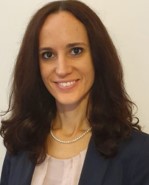 |
Dr. Federica Caselli is Associate Professor of Biomedical Engineering at University of Rome Tor Vergata. She graduated in Medical Engineering, in Mathematics, and obtained her Ph.D. in advanced computational methods in biomechanics. Dr. Caselli's research deals with the development of lab-on-a-chip devices for diagnostics and life science, with a special focus on microfluidic impedance cytometry. She seeks novel solutions for single-cell biophysical phenotyping and manipulation, by using model-based device design, signal processing and data analytics. She has published about a hundred contributions in journals, conference proceedings and book chapters, and she was awarded a grant from the "Scientific Independence of Young Researchers Programme". |
|
Poster: |
|
Webinar, 16th of December 2020, 17:00 (Berlin CET) organized within the activities of the DAAD project HertSS and in cooperation with the German Chapter of the IEEE Education Society
Metal-organic Frameworks as New Materials for Various Sensing Applications |
|
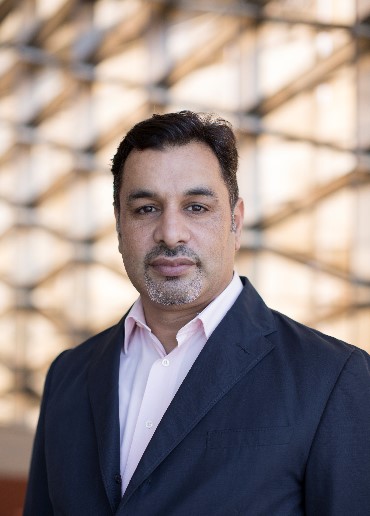 |
Dr. Osama Shekhah is a Senior Research Scientist and group leader in the FMD3 group of Prof. Mohamed Eddaoudi at King Abdullah University of Science and Technology in Kingdom of Saudi Arabia. He received his PhD in the field of physical and surface chemistry in 2004 from the Free University Berlin and Fritz-Haber Institute of the Max Planck Society under the supervision of Prof. R. Schlogl. Followed by one year as a postdoc at the Fritz-Haber institute in Berlin. In 2005 he was an exchange visitor at Stanford University in USA then joined the physical chemistry group of Prof. C. Woll at the Ruhr-University Bochum in Germany as a staff scientist. In 2009 he moved to Karlsruhe Institute of Technology in Germany with Prof. C. Woll as a group leader at the institute of functional interfaces. He has co-authored over 100 peer-reviewed articles in the field of surface science, catalysis and functional materials and their application. |
|
Poster: |
|
Webinar, 9th of December 2020, 17:00 (Berlin CET) organized within the activities of the DAAD project HertSS and in cooperation with the German Chapter of the IEEE Education Society
Plasmons for Enhancing Optical Sensing of Chemical Substances |
|
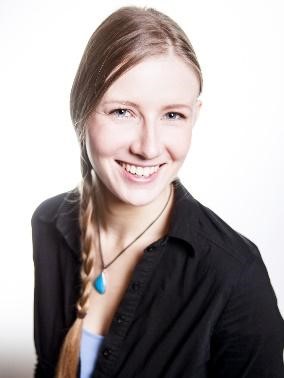 |
Prof. Evgeniya Sheremet was awarded a Ph.D. from the Chemnitz University of Technology in Experimental Physics in 2015 for her thesis in "Micro- and nano-Raman characterization organic and inorganic materials". Then she continued her work on nanocharacterization including finite element simulations of the electromagnetic field in the Solid Surfaces Analysis group of TU Chemnitz. From 2017 she became a full Professor at Tomsk Polytechnic University, Russia, where she continues her work as a group leader in the field of nanospectroscopy, flexible electronics. |
|
Poster: |
|
Webinar, 3nd of December 2020, 16:00 (Berlin CET) organized within the activities of the DAAD project HertSS and in cooperation with the 13th International Workshop on Impedance Spectroscopy (IWIS) and the German Chapter of the IEEE Education Society
Re-engineering the Assessment of Muscle Through the Use of Electrical Impedance Technologies: From Muscular Dystrophy to Mars |
|
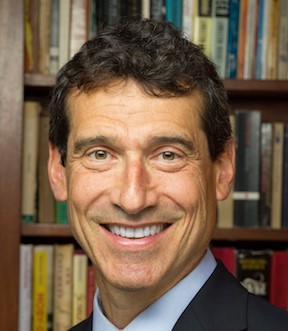 |
Prof. Seward Rutkove is Professor of Neurology, Harvard Medical School and serves as Chief of the Division of Neuromuscular Disease in the Department of Neurology at Beth Israel Deaconess Medical Center. With support from NIH, Dr. Rutkove?s medical research focuses on the application of innovative techniques for the assessment of neuromuscular disorders and muscle dysfunction with an emphasis on electrical impedance and ultrasound methodologies. His research efforts have also included the study of partial gravity analogue models in rodents with past and ongoing support from NASA. An investigator with over 200 publications, he is currently serving as an associate editor for Annals of Neurology. In 2011, he was awarded the Biomarker Challenge Prize from the non-profit foundation Prize4Life, Inc for his work demonstrating that electrical impedance measurements of muscle could speed clinical therapeutic studies in amyotrophic lateral sclerosis. In 2019, he received the Herman P. Schwan International Award in Electrical Bioimpedance. He is also a co-founder of Myolex, Inc and Haystack Diagnostics, Inc, two small businesses focused on the development of electrical impedance devices for the assessment of muscle in health and disease. |
|
Poster: |
|
Webinar, 2nd of December 2020, 15:00 (Berlin CET) organized within the activities of the DAAD project HertSS and in cooperation with the Advance School on Impedance Spectroscopy/ (ASIS) and the German Chapter of the IEEE Education Society
Developing Low-Cost Bioimpedance Meter for Biomedical and Biological Applications |
|
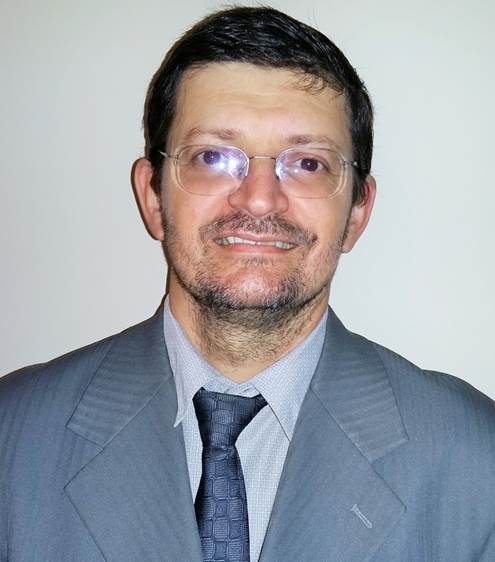 |
Prof. Pedro Bertemes Filho was graduated in Electrical Engineering in 1995 at the State University of Santa Catarina and PhD in Medical Physics at the University of Sheffield. He was a Fulbrighter at Dartmouth College and visiting researcher in the University of Ljubljana. He is a Titular Professor in UDESC since 2004, lecturing electronic instrumentation and coordinating a research group in biomedical engineering. IEEE member since 2007. Reviewer of more than 10 international journals. He is the chair of the coming CLAIB 2022 and secretary of the ISEBI. International lectures in renowned Universities, such as Uruguay, Ljubljana, Sheffield, Copenhagen and Mexico. Areas of research interest are focused on electrical bioimpedance and bioinstrumentation, Biosensor and e-Health. He edited the book entitled "Bioimpedance in Biomedical Applications and Research" published by Springer and the coming one entitled "Medicine Based Informatics and Engineering". |
|
Poster: |
|
Webinar, 27th of November 2020, 15:40 (Berlin CET) organized within the activities of the DAAD project HertSS and in cooperation with the International School on Smart Materials for Energy Conversion (ASMEC) , the IM Chapter IEEE Germany Section and German Chapter of the IEEE Education Society
Applications of Smart Materials and Artificial Intelligence in Fibrous Structures |
|
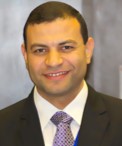 |
Dr. Mohamed Eldessouki is an Associate Professor at the Technical University of Liberec (Liberec, Czech Republic) and Mansoura University (Mansoura, Egypt). He also Marie Skodowska-Curie Fellow Scientist at Swiss Federal Laboratories for Materials Science and Technology (Empa, Switzerland). His research interest is the Smart Materials and their implementation for health monitoring applications. He works on utilizing the Scientific Computations to study and analyze polymeric biomaterials, nanocomposites, and fibrous structures. Dr. Eldessouki graduated from Auburn University (Auburn, AL-USA) with two Master Degrees in Chemical Engineering (CHEN) and Polymer and Fiber Engineering (PFEN). |
Nano-Domains Assisted Energy Transfer in Amphiphilic Polymer Co-networks for Wearable Luminescent Solar Concentrators |
|
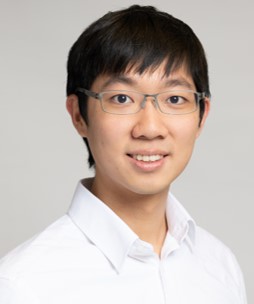 |
Chieh-Szu Huang received his B.S. in Materials Science and Engineering and M.S. in Electrical Engineering at the National Cheng Kung University in Taiwan. He is currently a Ph.D. candidate in Chemistry at Empa, the Swiss Federal Laboratories for Materials Science and Technology and ETH Zurich, Swiss Federal Institute of Technology Zurich in Switzerland. His research interests are on the general nano-materials and photon energy transfer for the application of electronic devices, solid state lighting, and solar energy harvesting. |
|
Poster: |
|
Webinar, 27th of November 2020, 14:00 (Berlin CET) organized within the activities of the DAAD project HertSS and in cooperation with the International School on Smart Materials for Energy Conversion (ASMEC) , the IM Chapter IEEE Germany Section and German Chapter of the IEEE Education Society
Design of Piezoelectric and Pyroelectric Composites for Harvesting and Sensing |
|
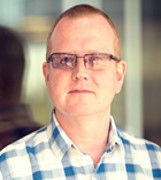 |
Prof. Christopher Rhys Bowen has a BSc degree in Materials Science from the University of Bath (1986-1990) and a DPhil in Ceramics from the University of Oxford (1990-1993). Post-doctoral work has been undertaken at Tecnische Universität Harburg-Hamburg and University of Leeds (1994-1996). He was Senior Scientist at the Defense Evaluation and Research Agency from 1996-1998. He joined the University of Bath as a Lecturer in 1998 and is now Professor of Materials. Research areas include energy harvesting, piezoelectric materials, dielectrics and functional ceramics. |
|
Poster: |
|
Webinar, 25th of November 2020, 16:00 (Berlin CET) organized within the activities of the DAAD project HertSS and in cooperation with the International School on Smart Materials for Energy Conversion (ASMEC) , the IM Chapter IEEE Germany Section and German Chapter of the IEEE Education Society
Ferrite Magnetic-oxide for Energy Harvesting and Other Applications |
|
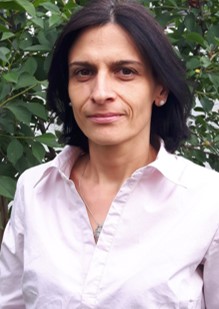 |
Prof. Georgeta Salvan received a M.Sc. degree in Physics at the Babes-Bolyai University in Cluj-Napoca, Romania, in 1999 and a Ph.D. in Physics at the Chemnitz University of Technology in 2003. After a postdoctoral research period at the University of Wales Aberystwyth, UK, she became Junior professor for Organic Semiconductors at the Chemnitz University of Technology in December 2003. Since 2009 she is apl. Professor at the Institute of Physics of the Chemnitz University of Technology. Her current research activities include magneto-optical, magneto-transport and magnetic investigations of magnetic oxides, magnetic layer stacks, organic materials as well as of organic/inorganic hybrid structures. |
|
Poster: |
|
Webinar, 18th of November 2020, 17:00 (Berlin CET) organized within the activities of the DAAD project HertSS and in cooperation with the IM Chapter IEEE Germany Section and German Chapter of the IEEE Education Society
Chemical Sensing, Possibilities and Research AreasChemical sensors are experiencing a deep research concerning promising materials and modelling due to the need from the industrial sector to have reliable and long-lasting devices. Durability testing is often not possible for chemical sensors and therefore accurate studies on innovative materials are conducted. In this presentation several commercial and research chemical sensors based on semiconductors will be discussed as well as their modelling exploring different exploitation areas. |
|
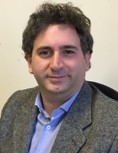 |
Dr. Marco Mugnaini got his Ph.D. in reliability availability and logistics, University of Florence, Italy, 2003 and the Laurea Degree (110/110 cum Laude) in Electronics Engineering with major in Non-Linear Automatic Controls, University of Florence, Italy, 1999. Currently, he is Associate Professor at the University of Siena (Manager of the electronics training lab.), University of Siena, Italy. He has been appointed as faculty and Professor at the Electrical and Electronics Technology Dept. at the Higher Colleges of Technology Abu Dhabi, UAE in 2012 - 2013. From 2005 to 2012 he was an Assistant Professor at the University of Siena (Manager of the electronics training lab.), University of Siena. He is author and co-author of more than 165 papers in International peer reviewed journal and conferences and of 5 national and international patents. |
|
Poster: |
|
Webinar, 11th of November 2020, 17:00 (Berlin CET) organized within the activities of the DAAD project HertSS and in cooperation with the German Chapter of the IEEE Education Society
The future of graphene-based materials for flexible electronicsThe successful large-scale technological application of graphene strongly depends on the development of new processes for the synthesis, functionalization, and integration into devices. In this regard, a strong research focus is being given to inexpensive methods such as laser processing and 3D printing. These inexpensive processing methods play also a role in the integration of graphene in an economically sustainable way. Thus, in this keynote presentation, we will discuss the latest methods being developed for the integration of graphene into flexible electronics. We will pay particular attention to the challenges and opportunities opened in biomedical sensors, energy applications, and wearable electronics that are critical for the future realization of technological paradigms such as the Internet of Everything. |
|
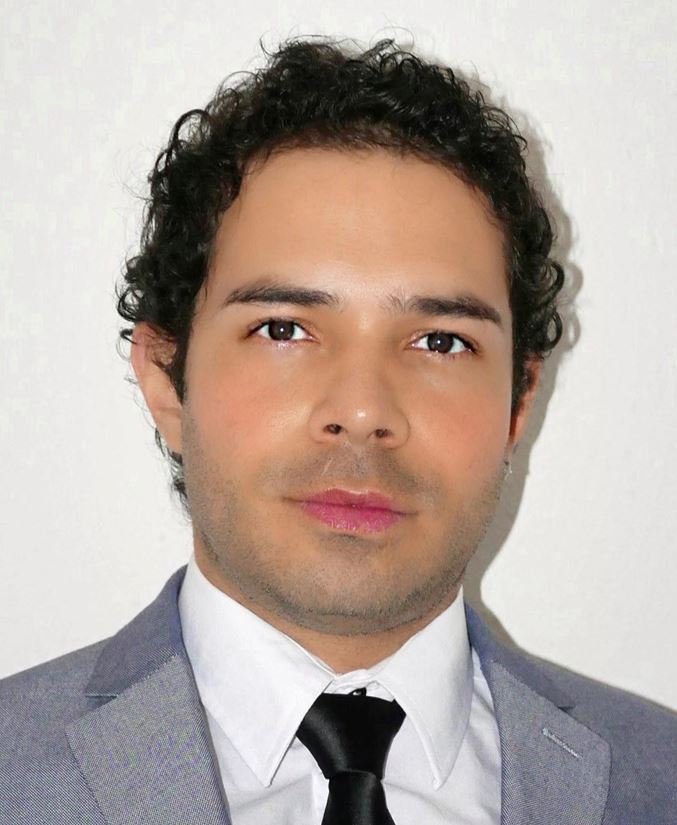 |
Prof. Dr. Raul D. Rodriguez received a Ph.D. in Physics and Chemistry of Nanomaterials in 2009 with the highest honors at the Institut des NanoSciences de Paris, Pierre et Marie Curie University (Sorbonne Universités) Paris, France. In 2011, he joined the DFG Research Unit Sensoric Micro- and Nano-Systems (SMINT) in the Semiconductor Physics group at TU Chemnitz, Germany. His experience includes the implementation and development of novel methods for nanoscale characterization (TERS, CSAFM, KPFM, and nan,o-Vis). He was appointed in 2017 as a Full Professor at Tomsk Polytechnic University, Tomsk, Russia. He focuses on flexible electronics, particularly novel plasmonic and 2D nanomaterials for technological developments including biomedicine, optoelectronics, energy, and safety applications. |
|
Poster: |
|
Webinar, 4th of November 2020, 17:00 (Berlin CET) organized within the activities of the DAAD project HertSS and in cooperation with the German Chapter of the IEEE Education Society
From Surface Enhanced Raman to Photo-Induced Enhanced Raman Spectroscopy: Basic Aspects and Applications to Molecular and Biomolecular SensingSurface Enhanced Raman Spectroscopy (SERS) takes advantage of the peculiar optical properties of noble metal nanoparticles (MNPs) to amplify the extremely weak Raman scattering of molecular compounds. The aim of this talk is to give an overview of the electromagnetic and chemical phenomena at the base of the signal enhancement in SERS and Photoinduced enhanced Raman spectroscopy (PIERS), focusing on the nanomaterials that make these effects possible. In particular, we will introduce two-dimensional (2D) layered transition-metal dichalcogenides (2DMX2), recently shown by our groups as very promising materials for PIERS. Applications of SERS/PIERS in the fields of security, health and food contamination detection are finally shown. |
|
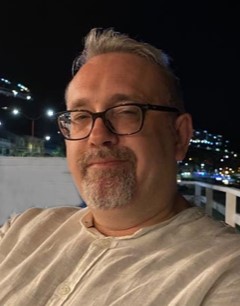 |
Pietro G. Gucciardi earned a PhD in physics from the University of Firenze after obtaining a Laurea in Physics at the University of Pisa, in Italy. He is currently Research Director at the Institute for Chemical-Physical Process (IPCF) of the National Research Council of Italy (CNR) in Messina, Italy. He is Founder and Responsible of the NanoSoftLab@IPCF. Dr Gucciardi has extensive experience in near-field optical microscopy and plasmon-enhanced spectroscopies (SERS/TERS). His research includes the combination of optical tweezers with Raman/SERS spectroscopy for the analysis of individual nanostructures and nanoplastics, and the development of advanced nanobiosensors based on hybrid metal-2D layered materials. In 1997 he received the "Philip Morris award for scientific research and technology" and in 2009 the "CNR award for strategic research 2005." He is author of more than 120 peer-reviewed articles that have received more than 3800 citations (H-index 31, Google Scholar). |

